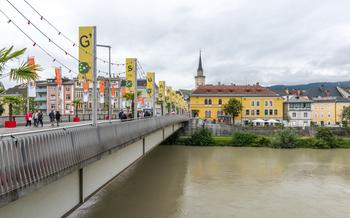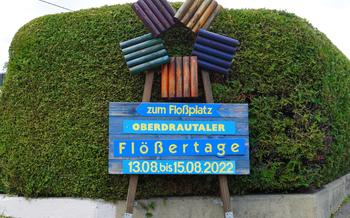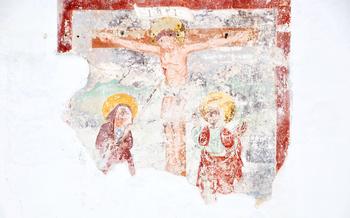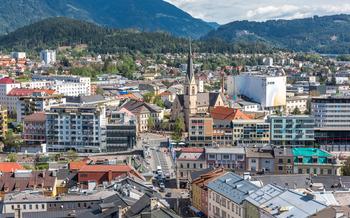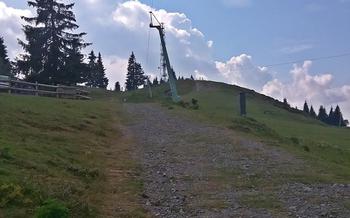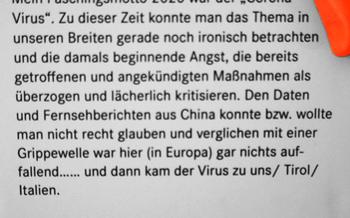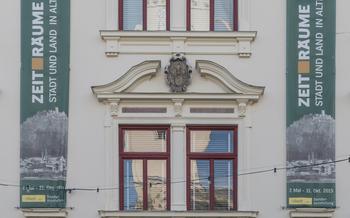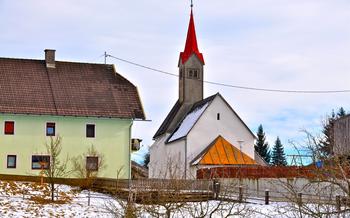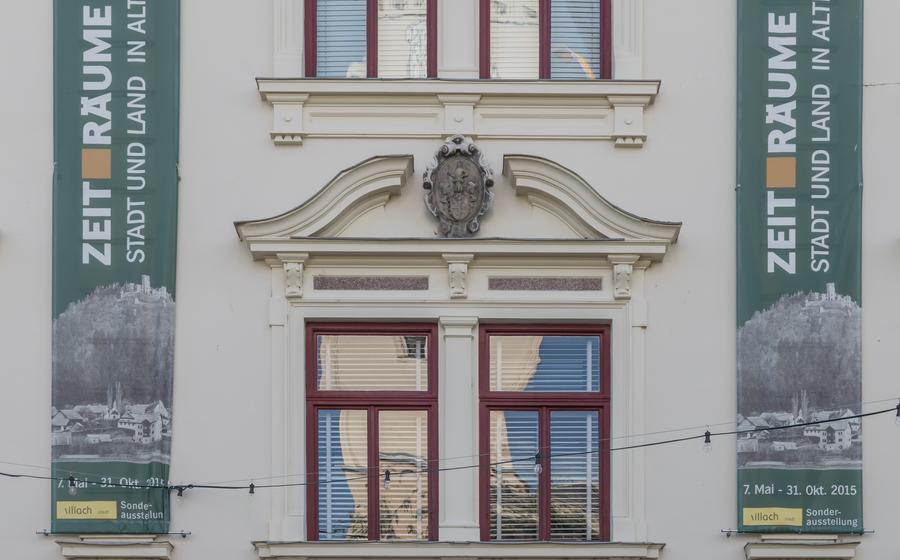
Museum of the City of Villach (Stadtmuseum Villach)
- Museum of the City of Villach
- Villach's History Unraveled
- The Roman Era in Villach:
- Medieval Villach:
- Renaissance and Baroque Influence
- The Industrial Revolution's Impact
- 20th-Century Challenges and Developments
- Villach's Diverse Heritage
- Special Exhibitions and Events
- Research and Education
- Guided Tours
- Accessibility and Facilities
- Visitor Tips
- Nearby Attractions
- Insider Tip: Unraveling a Hidden Secret
Museum of the City of Villach
Embark on a journey through time at the Museum of the City of Villach (Stadtmuseum Villach), a treasure trove of history and culture nestled in the heart of this charming Austrian city. Located on Widmanngasse 38, a mere stone's throw from the main square, the museum invites you to delve into Villach's rich past, from its humble beginnings to its rise as a vibrant city.
Easily accessible by foot or public transportation, the museum's doors are open from Tuesday to Sunday, welcoming visitors to explore its fascinating exhibits. Regular admission fees apply, but discounts are available for children, students, and seniors.
Villach's History Unraveled
The Museum of the City of Villach houses a remarkable collection of archaeological findings, historical documents, and artifacts that narrate the captivating story of Villach's past. Unearthed from excavations across the region, these treasures provide tangible evidence of human presence dating back to the Stone Age. Visitors can marvel at ancient tools, pottery shards, and jewelry that offer glimpses into the lives of Villach's earliest inhabitants.
Historical documents and manuscripts, meticulously preserved within the museum's archives, shed light on the city's rich and tumultuous past. Charters, chronicles, and legal records document the rise of Villach as a trading hub, the construction of its fortifications, and the impact of major historical events. These documents, often adorned with intricate calligraphy and seals, transport visitors back in time, allowing them to witness the unfolding of Villach's history firsthand.
Interactive exhibits and multimedia displays bring Villach's past to life, engaging visitors of all ages. Touchscreens, interactive maps, and virtual reality experiences invite visitors to explore the city's landmarks, immerse themselves in historical events, and learn about the people who shaped Villach's destiny. These innovative displays transform the museum into a vibrant and dynamic space, making history accessible and enjoyable for everyone.
The Roman Era in Villach:
Villach's rich history dates back to the Roman era, which significantly influenced the region's culture and development. Archaeological excavations have unearthed remnants of Roman settlements, including foundations of buildings, pottery fragments, and coins. These discoveries provide valuable insights into the daily lives, trade, and interactions of the Roman inhabitants.
One of the highlights of the museum's collection is an extensive array of artifacts from Roman excavations. Visitors can marvel at well-preserved pottery, jewelry, tools, and sculptures that showcase the artistic skills and craftsmanship of the Roman artisans. These artifacts offer a glimpse into the material culture and everyday objects used by the Roman settlers.
The museum also explores the integration of Roman culture into local traditions. The Romans introduced viticulture, agriculture techniques, and architectural styles that left a lasting impact on the region. The adoption of Roman customs and beliefs, such as the worship of Roman deities, further enriched the cultural tapestry of Villach.
Medieval Villach:
During the Middle Ages, Villach emerged as a significant trading hub, strategically positioned at the crossroads of important trade routes connecting the Holy Roman Empire with the Adriatic Sea. The city's favorable location attracted merchants and traders from across the region, contributing to its economic growth and prosperity.
The rise of Villach as a trading center necessitated the construction of fortifications to protect its valuable goods and secure its position. The city walls, towers, and gates were meticulously designed to withstand potential attacks and safeguard the city's inhabitants. The well-preserved fortifications stand as a testament to the ingenuity and foresight of medieval engineers and serve as a reminder of the city's rich history.
Life in medieval Villach was vibrant and diverse, reflecting the confluence of cultures and traditions. Merchants from various backgrounds mingled in the marketplace, exchanging goods and ideas. Artisans skillfully crafted intricate wares, contributing to the city's reputation for high-quality craftsmanship. The streets bustled with activity as locals and visitors alike engaged in trade, celebrated festivals, and participated in religious processions.
Renaissance and Baroque Influence
The Renaissance and Baroque periods marked a significant chapter in Villach's history, leaving a profound impact on its artistic and architectural landscape. During this era, Villach experienced a flourishing of trade and commerce, attracting skilled artisans, artists, and intellectuals from across the region.
Artistic Masterpieces:
- The museum houses a collection of exquisite paintings, sculptures, and other artworks created during the Renaissance and Baroque periods.
- Notable works include paintings by Hans von Aachen, Giovanni Antonio Canaletto, and Bartolomeo Altomonte, showcasing the influence of Italian and Flemish artistic traditions.
- Visitors can admire the intricate details, vibrant colors, and expressive forms that characterized the artistic output of this era.
Architectural Wonders:
- The museum also features exhibits on the architectural developments of the Renaissance and Baroque periods in Villach.
- Visitors can learn about the construction of magnificent buildings, such as the Villacher Rathaus (Town Hall) and the St. Jakobskirche (Church of St. James), which exemplify the architectural styles of the time.
- These buildings, with their ornate facades, elaborate interiors, and symbolic significance, stand as testaments to the city's cultural and artistic heritage.
Integration of Cultures:
- The Renaissance and Baroque periods witnessed a remarkable integration of Roman, Gothic, and Renaissance elements into local traditions, creating a unique blend of architectural and artistic styles.
- This fusion of influences is evident in the city's churches, palaces, and public buildings, each telling a story of cultural exchange and artistic evolution.
- The museum offers insights into the ways in which Villach's cultural identity was shaped by the diverse influences of this era.
The Industrial Revolution's Impact
The Industrial Revolution brought about significant changes to Villach, transforming it from a predominantly agricultural town into a bustling industrial center. The Drau River played a crucial role in this transformation, serving as a vital waterway for trade and transportation. It facilitated the movement of goods and raw materials, enabling the establishment of factories and industries along its banks. The rise of industries led to increased employment opportunities and economic growth, attracting people from surrounding areas to seek work in Villach. This influx of workers contributed to the city's growing population and its emergence as a major industrial hub within the region.
20th-Century Challenges and Developments
The 20th century brought significant challenges and developments to Villach. The city endured the turmoil of World Wars I and II, which left deep scars on its physical and social fabric. Post-war reconstruction and economic recovery were arduous tasks, but Villach emerged from these trials as a resilient and modern city.
During the early 20th century, Villach witnessed the rise of industrialization. The Drau River, a vital waterway, played a crucial role in trade and transportation, facilitating the growth of factories and industries. This transformation brought economic prosperity and job opportunities, but it also posed challenges related to urbanization and social inequality.
The post-war era was marked by a remarkable spirit of resilience and renewal. Villach rebuilt its infrastructure, restored its cultural institutions, and embraced new technologies. The city's economy diversified, transitioning from traditional industries to sectors such as tourism, services, and advanced manufacturing.
Today, Villach stands as a vibrant and modern city that has successfully navigated the challenges of the 20th century. Its rich history and cultural heritage, coupled with its commitment to innovation and sustainability, position Villach as a progressive city poised for continued growth and prosperity.
Villach's Diverse Heritage
Villach's history and culture have been shaped by various influences, reflecting its diverse heritage. The city has been home to different ethnicities and cultures throughout history, including Celtic tribes, Romans, Slavs, and Germans. Each group has left its mark on the city's history, traditions, and way of life.
The Habsburg Empire played a significant role in Villach's development. As part of the empire, Villach experienced a period of economic and cultural prosperity. The city became a hub for trade and commerce, attracting merchants and artisans from across the empire. The legacy of the Habsburgs can still be seen in the city's architecture, particularly in the Baroque and Renaissance buildings that adorn its streets.
Despite its diverse influences, Villach has managed to maintain its unique identity. The city has successfully integrated traditional customs and modern lifestyles, creating a harmonious blend of old and new. Visitors to Villach can experience this vibrant diversity through the city's festivals, cuisine, and cultural events.
Special Exhibitions and Events
The Museum of the City of Villach goes beyond its permanent collection by hosting a variety of special exhibitions that delve into specific themes related to the city's history and culture. These temporary displays showcase unique artifacts, documents, and artworks that offer visitors fresh perspectives and insights into Villach's rich heritage.
The museum collaborates with other institutions and organizations to curate these exhibitions, ensuring a diverse range of topics and perspectives. From in-depth explorations of Villach's industrial past to artistic expressions inspired by the city's natural surroundings, these special exhibitions offer something for every visitor.
In addition to exhibitions, the museum hosts cultural events, workshops, and lectures that complement its collection and mission. These events provide opportunities for visitors to engage with historians, curators, and experts, fostering a deeper understanding of Villach's past and its relevance to contemporary society.
The museum's commitment to showcasing special exhibitions and hosting cultural events underscores its dynamic and engaging approach to preserving and presenting Villach's history. Visitors are encouraged to check the museum's website or inquire at the information desk for details about upcoming exhibitions and events.
Research and Education
The Museum of the City of Villach plays a crucial role in preserving and disseminating historical knowledge through its extensive research and educational initiatives. The museum's team of dedicated researchers delves into various aspects of Villach's past, conducting in-depth studies, analyzing artifacts, and uncovering new insights into the city's rich history. Their findings are meticulously documented and shared through publications, seminars, and conferences, contributing to a deeper understanding of the region's heritage.
Educational programs are an integral part of the museum's mission, catering to students of all ages and visitors seeking to expand their knowledge. Interactive workshops, guided tours tailored to specific educational levels, and hands-on activities bring history to life for young learners. The museum also offers lectures, seminars, and workshops for adults, providing opportunities for continuous learning and exploration of Villach's past.
The museum's commitment to education extends beyond its walls, as it actively collaborates with schools, universities, and cultural institutions to develop educational resources and programs. Through partnerships and outreach initiatives, the museum aims to foster a sense of appreciation for local history and culture among the younger generation, ensuring that the legacy of Villach continues to inspire and educate future generations.
Guided Tours
The Museum of the City of Villach offers guided tours that provide visitors with a deeper understanding of the museum's collection and the history of Villach. These tours are conducted by knowledgeable and experienced guides who bring the exhibits to life and share fascinating insights into the city's past.
Visitors can choose from a variety of guided tours, depending on their interests and time constraints. General tours offer a comprehensive overview of the museum's highlights, while thematic tours focus on specific aspects of Villach's history, such as the Roman era, the Middle Ages, or the Industrial Revolution.
Guided tours are available in German and English, with other languages available upon request. Visitors are advised to book their tours in advance, especially during peak tourist season, to ensure a spot.
During the tour, visitors will have the opportunity to ask questions and engage in discussions with the guide. This personalized experience allows visitors to gain a deeper appreciation for the museum's collection and the rich history of Villach.
Accessibility and Facilities
The Museum of the City of Villach is committed to providing an inclusive and welcoming environment for all visitors. Wheelchair accessibility is ensured throughout the museum, with ramps and elevators connecting different levels. Accessible restrooms are also available for the convenience of visitors with disabilities.
Families with young children will find the museum to be a welcoming and educational space. A dedicated children's corner provides interactive exhibits and activities designed to engage and entertain younger visitors. The museum also offers family-friendly guided tours that cater to the interests and attention spans of children.
For those who wish to take home a piece of their museum experience, a gift shop is located on-site. The shop offers a variety of souvenirs, including books, postcards, and replicas of artifacts from the museum's collection. Educational materials, such as brochures and guides, are also available for purchase.
Visitor Tips
-
Recommended time for a visit: Allow at least two hours to fully explore the museum's exhibits and displays. Plan your visit during the museum's open hours, which are typically from Tuesday to Sunday, 10 am to 5 pm.
-
Photography guidelines and restrictions: Photography is generally allowed in the museum, but flash photography and tripods are not permitted. Please respect the museum's guidelines to ensure the preservation of the artifacts and artworks.
-
Tips for exploring the museum with children: The museum offers interactive exhibits and educational programs specifically designed for younger visitors. Take advantage of these resources to engage your children and make their visit more enjoyable. The museum also provides a children's corner where kids can participate in hands-on activities and learn about Villach's history through play.
Nearby Attractions
Villach is a treasure trove of cultural and historical landmarks that beckon travelers to explore beyond the Museum of the City of Villach. The Villach Carinthian Museum of Modern Art showcases a diverse collection of contemporary artworks, while the Villach Folklore Museum delves into the region's rich traditions and customs.
For those drawn to the performing arts, the Villach Congress Center hosts a variety of theater productions, concerts, and exhibitions throughout the year. Music enthusiasts can immerse themselves in the city's vibrant music scene at the Villach Music School or the Carinthian Symphony Orchestra.
Nature lovers will find solace in the breathtaking landscapes surrounding Villach. The Dobratsch mountain range, with its towering peaks and pristine lakes, offers a haven for hiking, biking, and skiing enthusiasts. The Villach Alpine Garden boasts a vast array of alpine flora, providing a tranquil retreat for those seeking serenity amidst nature's wonders.
Villach's proximity to other captivating destinations in Carinthia and beyond makes it an ideal base for further exploration. A short drive away lies the enchanting Lake Wörthersee, renowned for its crystal-clear waters and picturesque lakeside villages. History buffs can delve into the medieval past at the Hochosterwitz Castle, perched majestically on a rocky outcrop.
With its rich cultural heritage, stunning natural surroundings, and convenient access to neighboring attractions, Villach promises an unforgettable journey that will leave visitors yearning for more.
Insider Tip: Unraveling a Hidden Secret
Embark on a journey of discovery as you uncover the museum's hidden treasure—a secret passageway leading to a forgotten chamber. This clandestine portal, concealed within the museum's depths, transports you back in time, revealing a world of untold stories and forgotten relics. As you step through the threshold, a sense of awe and intrigue envelops you, drawing you deeper into the museum's captivating narrative. Let your curiosity guide you as you explore this enigmatic space, where whispers of the past dance in the air, waiting to be deciphered.

